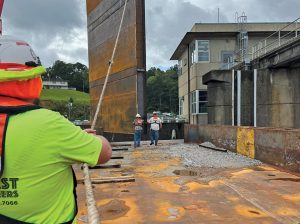Holt Lock on the Black Warrior River reopened at 7 a.m. October 2, 102 days after cracks in a monolith caused an unscheduled shutdown.
The Mobile Engineer District is planning to operate the repaired lock from 7 a.m. to 7 p.m. for two weeks and then assess whether to run it around the clock. Tows three barges wide, the widest the lock can accommodate, are authorized. Four northbound tows transited the lock on the first day of operation.
The temporary fix involved installing a bulkhead in front of a problematic fill culvert that runs through the base of a cracked monolith, essentially sealing it off from the upstream pressure of the river.

Crews lift a bulkhead into place at Holt Lock on the Black Warrior River near Tuscaloosa, Ala. The bulkhead is part of a temporary fix to address cracks and movement in one of the lock’s monoliths. (Photo by Matthew Cornelison)
In a discussion with the Mobile District commander Col. Jeremy Chapman, Wynne Fuller, president of the Warrior-Tombigbee Waterway Association, indicated that the bulkhead was performing exactly as designed, and the stability of monolith 14 has been restored. Several cycles of the lock determined that there was no significant movement of the wall, he said.
The Corps continues to pursue a permanent solution. Project manager Scott Ellzey said his team is proceeding with an urgency as if the lock were still closed. Long-term repairs will involve installing anchor rods and pressure grouting cracks. The installation of both vertical and horizontal post-tension anchor rods will effectively “sew” the monolith back together. The cracks extend the full height and full width of the monolith.
Holt Lock was built in 1966 and has exceeded its design life.
In the last of a series of conference calls on the temporary fix to the lock on October 2, William “Vern” Gwin, chief of the district’s operations division, praised the efforts of the entire Corps team and its contractors, calling it a “jam-packed effort” to open the lock in the shortest possible time. Corps officials said the bulkhead was put together from three separate pieces on September 25 and installed September 28. Anthony Perkins, Mobile District Black Warrior-Tombigbee project manager, said the bulkhead weighed about 100,000 pounds. Crews removed a mooring bitt on the monolith, and divers drilled a vent hole in the culvert. Teams used a remotely operated vehicle from Vicksburg, Miss., to inspect the bulkhead.
Gwin singled out Nelson Sanchez, operations division chief for the Mobile Engineer District, for praise. Sanchez retired just days before the re-opening. “He waited a long time for this day,” Gwin said. He also applauded the efforts of contractors R&D Maintenance, Specialty Diving and West Alabama Mechanical.
An engineering team began collecting continuous data on the monolith’s stability following the repairs on September 30. The only reason for the 12-hour operation initially, Gwin said in response to a question, is so that teams can visually inspect the repairs to the monolith and culvert as well as use sensors.
“Safety is always a top priority, and the plan was executed flawlessly and safely,” he said. Jason Krick, chief of the Mobile District’s engineering division, said live satellite telemetry will also be used to monitor the lock.
Ed Vincent, an engineer with the Louisville District, said instruments are monitoring the thermal temperature of the bulkhead as well as weather effects. “We have to keep an eye out to avoid false positives,” he said.
“Highest appreciation to the Corps of Engineers’ team of engineers, including those of Mobile District’s Engineering Division, the Inland Navigation Design Center and the Engineering Research and Development Center for developing and implementing this very innovative solution for this very complex challenge,” Fuller concluded.
Justin Murphree, operations manager for the Columbus, Miss., Corps office, said the Aberdeen and Stennis locks on the Tennessee-Tombigbee Waterway were also being reopened from scheduled maintenance. Aberdeen reopened October 1, and Stennis was expected to reopen October 4.
After again praising team members, Gwin said the unscheduled shutdowns of Holt Lock and Demopolis Lock earlier in the year have helped raise public awareness of the importance of the lock and dam system to commerce.




